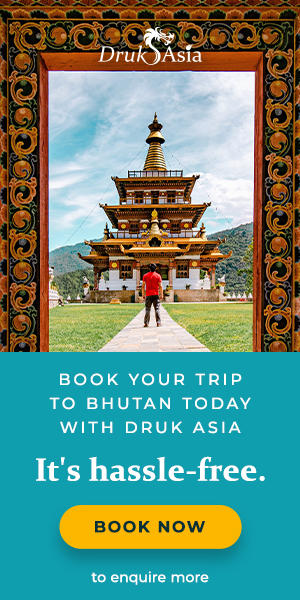The different types of prayer wheels in Bhutan
You'll find prayer wheels all over Bhutan. Inside each prayer wheel is a tightly rolled-up scroll of mantras. Spinning the wheel is equivalent to reciting the mantras.

The young and old spinning a prayer wheel is a common sight in Bhutan.
The prayer wheel can be traced to Tibet in the fourth century.
Buddhist texts speak of “turning the wheel of dharma” which led to the concept of the prayer wheel, a mechanical device that consists of an embossed hollow cylinder and a rod that runs through its height. Inside the rod is a tightly rolled-up scroll of mantras.
Spinning the prayer wheel is equivalent to reciting mantras. Each spin of the wheel is as effective as reciting the mantras orally, multiplied by the number of times the mantra is printed on the scroll.
The purpose of the prayer wheel is to relieve all living beings of their misery. When the mantra is recited, merit, peace, and kindness radiate through the world, bringing enlightenment to all sentient beings.
But there is more. Keep reading to learn about the prayer wheel.
Types of Prayer Wheels
There are six types of prayer wheels. They are:
-
Mani wheels
The Mani prayer wheel is portable. It has a cylindrical metal body mounted on a handle and can be rotated in a circular motion. Many tourists and pilgrims to Bhutan carry these. It is handheld and is usually used when the worshiper walks around a Buddhist relic or temple.

2. Fire wheels
A fire wheel is spun by a candle’s heat or electric light. The wheel then emits light and cleanses the bad karma from whoever touches it.
3. Water wheels
Water wheels are turned by flowing water. The water that touches the wheel is considered blessed water and can purify all living forms.

4. Fixed wheels
Fixed wheels can be found in the monasteries and dzongs of Bhutan. They are placed side by side in a row, or on its own if it’s a big one.


5. Wind wheels
The wind spins the wind wheel, cleaning the negative karma from anything that touches the wheel.

6. Electric dharma wheels
Electricity powers these wheels, so they can spin non-stop.
How to use a prayer wheel
Using a prayer wheel is simple.
With pointed concentration of your body, speech, and mind, spin the wheel clockwise. The wheel is easy to spin and should not require much strength. Some believe that the Meditational Deities, Dakinis, and Dharma Protectors automatically help the worshiper when they spin the wheel.
The wheel can be spun during daily meditation or when reciting mantras. You could spin it while circumambulating a stupa. You could also spin the wheel while watching TV.
However, it is not to be spun while the Lama is speaking or offering spiritual teachings.
Tip: Always move in a clockwise direction when circumambulating a prayer wheel.
Benefits of spinning the prayer wheel
According to ancient Buddhist traditions, spinning the wheel brings you merit and purifies your soul. The more you spin, the more merits you gain, leading to a higher chance of entering Nirvana. Nirvana is the state of being without personal desire, which is the ultimate goal of Buddhists (think of it as “heaven”).
Moreover, spinning the prayer wheel leads to self-actualisation and finally enlightenment. The wheel also grants wishes to the worshipper who spins it.
Similarly, if the wheel is spun while feeling remorse and guilt, you get relieved of some of the bad deeds.
Spinning the wheel at least once in your life ensures that you will not be reborn with abnormalities like deafness, blindness, muteness, or being crippled.
The mantra on the prayer wheel
You will see a six-syllable mantra on most prayer wheels. It is: Om Mani Padme Hum.

Here is what each syllable mean:
Om — Refers to generosity. Chanting it purifies the pride and ego from one’s human self. It is represented by white colour with the symbol of Deity-wisdom.
Ma — Addresses the jealousy, ethics, and lust for entertainment in the body. Green colour represents this, and it has the symbol of Deity-compassion.
Ni — Represents patience and purifies one’s passion and desire. It is denoted by the colour yellow, and has the symbol of Deity-body, speech, mind, and activity.
Pad — Pad is diligence that removes ignorance in the human body. It is represented by blue colour and has the symbol of Deity-Equanimity.
Me — Speaks to the eradication of poverty and possessiveness in the human body. Me is depicted by the colour red and has the symbol of Deity-Bliss.
Hum — Represents wisdom that nullifies the aggression and hate in the body. It is represented by black colour. It has the symbol of Deity-Quality of Compassion.
Pilgrims spin the prayer wheel while reciting this too.
Listen to the soothing sound of prayer wheels:
View this post on Instagram
Where to find prayer wheels in Bhutan?
If you’d like to spin a prayer wheel in Bhutan, you will find one in most dzongs and monasteries.
Here are a few you might enjoy visiting:
- Tashichho Dzong in Thimphu
- Simtokha Dzong in Thimphu
- National Memorial Chorten in Thimphu
- Rigsum Pemai Dumra in Tsirang
- Punakha Dzong in Punakha
- Zuri Dzong in Paro
- Paro Dzong in Paro




